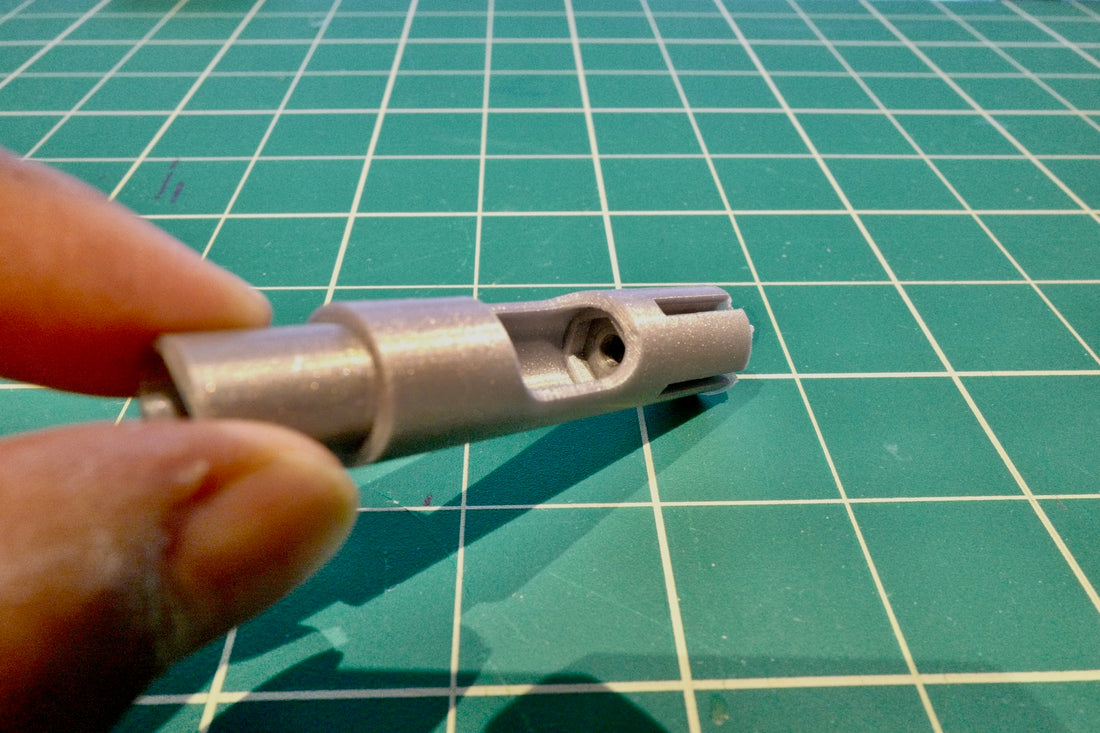3D printing is a new area of design that’s quickly evolving.
At first, people were just making cute objects, toys and vessels. Today, artists and industrial designers are making sophisticated sculpture, tools, furniture and even medical devices.
Why is design different for 3D printing?
Each material and manufacturing technique comes with its own design considerations and the designer needs to be aware of these considerations if their design is to succeed. In this post we are going to talk about 3D printing characteristics specific to the Homepod mini 3D printed stand.
How we reimagined our HomePod stand for 3D printing
When we designed our HomePod stands, we prototyped them using 3D printed versions of steel parts. Read more about how to prototype with a 3D printer here.
When we decided that a HomePod stand would be a fun DIY 3D print project, we had to rework almost everything. We keep the height the same because it was perfect for sound and touch and we also didn’t change the width of base because we liked its stability.
We knew we had to redesign the foot of the stand into something that would fit a small 3D printer, so we broke it down from a 12” diameter disc into legs about half that size. The main pole was too long to fit a printer bed so we designed our head and base to work with store-bought PVC pipe.
Read on for more 3D design tips, or if you’re ready to 3D print your own HomePod mini stand, we have a blog post to walk you through it.
How We Got a Workable Design We Could Share
Mating
A mate is the term to describe the connection point of two or more parts. There are three types of mates in the design and we will discuss each in detail.
1. A sliding mate between the pedestal and the inside of the CPVC tube
The inner shape of the CPVC tube is not perfectly circular so a tight fit is not possible. We have used a diameter of . . . measured using calipers and relied on some crush in the 15% infill 3D printed part to achieve a tight joint.
2. A sliding mate between the hub and the inside of the CPVC tube
The same consideration applies to the hub as does to the pedestal. We’ve made it pretty tight and then hammered it home when it wouldn’t fit easily by hand.
3. A sliding mate “dovetail” joint between the legs and the hub
It’s not really a dovetail because the shape of the tail is rounded for reasons of distributing loads in the small joint and weak material. We’ve used a tolerance of 0.01mm and the joint is tight and a little hard to slip on, but imparts confidence that it will stay in place.
Strength
3D printed parts, because they are made up of layers, are not as strong as molded plastic parts. Molded plastic is solid rather than layered and often reinforced with fiber inside them.
There were some concerns about the strength of the hub in bending since the weight of the Homepod has a long lever action at the base, so we minimized the opening for the cable ends. This took some trial and error since the fit of the end is a 3D problem, in that you can finagle it through in a way not easy to visualize and draw on the computer.
3D printed legs of this slender design and 20% infill are strong enough to provide stability against tipping, but not strong enough to keep the weight of the Homepod mini off the ground indefinitely without deformation. Over time the plastic tends to give. Therefore, it is essential to have support directly under the post. The hub acts as a fifth foot.
The pedestal is designed to be the same size as the flat bottom of the Homepod mini. Fortunately, this is sufficient area for the double-sided tape to work given the tape’s strength and the Homepod mini’s weight and flat surface. The Homepod mini is rather light. You couldn’t tape down the Homepod Classic, which doesn’t have a flat bottom and weighs quite a bit more.
The CPVC tube is a fresh water tube that’s supposed to be flexible so it can more easily run through holes in studs and joists in a home. Larger diameter PVC tubs are drain pipes and tend to be very rigid so there is no pooling of sewage. As a result of using the fresh water PVC the post will be slightly more flexible than one would like, but it works.

Manufacture/3D Printing
The primary consideration was to avoid printing support material inside the hub and pedestal. Any support material in there would be hard to get out. So, it’s super important that you print in the proper orientation.
Orientation with no supports required.

Orientation with a lot of supports required.

We chose a #8 screw so that the nut would capture inside the available diameter of the post while leaving sufficient materials around itself for strength.
In the interest of beauty, we chose a slender ½” CPVC tube. Our tubing choice meant we had to design the hub and pedestal carefully because the cable head is a very tight fit in the tube, leaving little space for the pedestal/hub and CPVC tube features to come together.

For the base, we elected to go with legs instead of the disc that we used for our steel design. This allowed us to reduce the major dimension to under half and fit the parts on a small 3D printer.
We can’t wait to see what 3D print objects you design
Hopefully, some of these design considerations will help you with your own 3D prints and also give you some insight into how NoBox thinks about design - even the ones we don’t make ourselves. We hope this lets you get to know us better.
Thanks for reading!
If you enjoyed this post, please share it with someone else you might think will enjoy it. Thank you!

